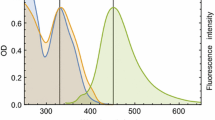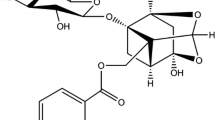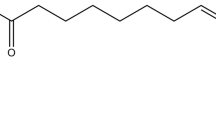Abstract
The interaction between 4-(4-fluorobenzylideneamino)-5-propyl-4H-1,2,4-triazole-3-thiol (FBTZ) and human serum albumin (HSA) under simulative physiological conditions was investigated by fluorescence, UV–vis absorption and circular dichroism (CD) spectroscopy as well as molecular modeling method. Fluorescence spectroscopic data showed that the fluorescence quenching of HSA was a result of the formation of FBTZ–HSA complex. According to the modified Stern–Volmer equation, the effective quenching constants (K a) of FBTZ to HSA were obtained at three different temperatures. The enthalpy change (ΔH) and entropy change (ΔS) were calculated on the basis of van′t Hoff equation, and the results showed that hydrogen-bonding and van der Waals forces were the dominant intermolecular forces to stabilize the complex. Site marker competitive replacement experiments demonstrated that the binding of FBTZ to HSA primarily took place in sub-domain IIA (Sudlow’s site I). The binding distance (r) between FBTZ and the tryptophan residue of HSA was estimated according to the theory of fluorescence resonance energy transfer. The conformational investigation showed that the presence of FBTZ induced some changes of secondary structure of HSA. Molecular modeling study further confirmed the binding mode obtained by experimental study.












Similar content being viewed by others
References
Parmar K, Suthar B, Prajapati S et al (2010) Synthesis and biological activity of novel 1,3,5-trisubstituted 1,2,4-triazole derivatives. J Heterocycl Chem 47:156–161
Ezabadi RR, Camoutsis C, Zoumpoulakis P et al (2008) Sulfonamide-1,2,4-triazole derivatives as antifungal and antibacterial agents: synthesis, biological evaluation, lipophilicity, and conformational studies. Bioorg Med Chem Lett 16:1150–1161
Kucukguzel I, Tatar E, Kucukguzel SG et al (2008) Synthesis of some novel thiourea derivatives obtained from 5-[(4-aminophenoxy)methyl]-4-alkyl/aryl-2,4-dihydro-3H-1,2, 4-triazole-3-thiones and evaluation as antiviral/anti-HIV and anti-tuberculosis agents. Eur J Med Chem 43:381–392
Sanghvi YS, Bhattacharya BK, Kini GD et al (1990) Growth inhibition and induction of cellular differentiation of human myeloid leukemia cells in culture by carbamoyl congeners of ribavirin. J Med Chem 33:336–344
Rudnicka W, Osmialowska Z (1979) Cyanoalkylation of 4-amino-1,2,4-triazole-3-thione. Acta Pol Pharm 36(4):411–419
Al-Masoudi NA, Yaseen AS, Al-Dweri MN (2004) Synthesis, antitumor and antiviral properties of some 1,2,4-triazole derivatives. Farmaco 59:775–783
Lopez RC (1993) Herbicidal 1-(disubstituted carbamoyl or thiocarbamoyl)-1,2,4-triazol-3-ylsulfonates and thiosulfonates. US Patent 5211739
Nakayama, Yoshida KR, Morita K (1989) Carbamoyltriazoles, and their production and use. US Patent 4810271
Zhu DR, Xu Y, Yu Z et al (2002) A novel bis(trans-thiocyanate)iron(II) spin-transition molecular material with bidentate triaryltriazole ligands and its bis(cis-thiocyanate)iron(II) high-spin isomer. Chem Mater 14:838–843
Cheng HM, Zhu DR, Lu W et al (2010) Synthesis and crystal structure characterization of 3,5-bis(2-quinolyl)-1,2,4-triazole. J Heterocycl Chem 47:210–213
Purser S, Moore PR, Swallow S, Gouverneur V (2008) Fluorine in medicinal chemistry. Chem Soc Rev 37:320–330
Brown JR, Shockley P (1982) Lipid–protein interactions, vol 1. Wiley, New York
Carter D, Ho JX (1994) Advances in protein chemistry, vol. 45. Academic, New York, pp 153–203
Gelamo EL et al (2002) Interaction of bovine (BSA) and human (HSA) serum albumins with ionic surfactants: spectroscopy and modeling. Biochim Biophys Acta 1594:84–99
Li JY, Zhu XL, Yang C, Shi RW (2010) Characterization of the binding of angiotensin II receptor blockers to human serum albumin using docking and molecular dynamics simulation. J Mol Model 16:789–798
He XM, Carter DC (1992) Atomic structure and chemistry of human serum albumin. Nature 358:209–215
Reidenberg MM, Erill S (1986) Drug-protein binding. Praeger, New York
Sudlow G, Birkett DJ, Wade DN (1975) Characterization of two specific drug binding sites on human serum albumin. Mol Pharmacol 11:824–832
Efrink MR, Ghiron CA (1981) Fluorescence quenching studies with proteins. Anal Biochem 114:199–227
Lakowicz JR (1999) Principles of fluorescence spectroscopy, 2nd edn. Plenum Press, New York, pp 237–265
Ashoka S, Seetharamappa J, Kandagal PB et al (2006) Investigation of the interaction between trazodone hydrochloride and bovine serum albumin. J Lumin 121:179–186
Lakowicz JR (2006) Principles of fluorescence spectroscopy, 3rd edn. Springer, New York
Zhang YZ, Xiang X, Mei P et al (2009) Spectroscopic studies on the interaction of Congo Red with bovine serum albumin. Spectrochim Acta A 72:907–914
Zhang YZ, Zhou B, Zhang XP et al (2009) Interaction of malachite green with bovine serum albumin: determination of the binding mechanism and binding site by spectroscopic methods. J Hazard Mater 163:1345–1352
Hu YJ, Liu Y, Sun TQ et al (2006) Binding of anti-inflammatory drug cromolyn sodium to bovine serum albumin. Int J Biol Macromol 39:280–285
Lehrer SS (1971) Solute perturbation of protein fluorescence. Quenching of the tryptophyl fluorescence of model compounds and of lysozyme by iodide ion. Biochemistry 10:3254–3263
Lakowicz JR (2006) Principles of fluorescence spectroscopy, 3rd edn. Plenum Press, New York, pp 277–285
Zhang YZ, Zhou B, Liu YX et al (2008) Fluorescence study on the interaction of bovine serum albumin with P-aminoazobenzene. J Fluoresc 18:109–118
Timaseff SN (1972) Proteins of biological fluids. Pergamon Press, Oxford, pp 511–519
Ross PD, Subramanian S (1981) Thermodynamics of protein association reactions: forces contributing to stability. Biochemistry 20:3096–3120
Il'ichev YV, Perry JL, Simon JD (2002) Interaction of ochratoxin a with human serum albumin. Preferential binding of the dianion and pH effects. J Phys Chem B 106:452–459
Förster T (1965) Delocalized excitation and excitation transfer. In: Sinanoglu O (ed) Modern quantum chemistry. Academic, New York, pp 93–137
Valeur B (2001) Molecular fluorescence: principles and applications. Wiley Press, New York
Cyril L, Earl JK, Sperry WM (1961) Biochemists’ handbook. E. & F. N, Spon
Kamat BP, Seetharamappa J (2004) In vitro study on the interaction of mechanism of tricyclic compounds with bovine serum albumin. J Pharm Biomed Anal 35:655–664
Cui FL, Fan J, Li JP, Hu ZD (2004) Interactions between 1-benzoyl-4-p-chlorophenyl thiosemicarbazide and serum albumin: investigation by fluorescence spectroscopy. Bioorg Med Chem 12:151–157
Zhang HX, Huang X, Mei P et al (2006) Studies on the interaction of tricyclazole with β-cyclodextrin and human serum albumin by spectroscopy. J Fluoresc 16:287–294
Sulkowska A (2002) Interaction of drugs with bovine and human serum albumin. J Mol Struct 614:227–232
Yang P, Gao F (2002) The principle of bioinorganic chemistry. Science Press, Beijing, pp 489–494
Cui FL et al (2009) Characterization of the interaction between 8-bromoadenosine with human serum albumin and its analytical application. Spectrochim Acta A 74:964–971
Li YS et al (2010) Interaction of coomassie brilliant blue G250 with human serum albumin: probing of the binding mechanism and binding site by spectroscopic and molecular modeling methods. J Mol Struct 968:24–31
Acknowledgments
We gratefully acknowledge the National Natural Science Foundation of China (20873096, 20921062, and 20621502) for financial support.
Author information
Authors and Affiliations
Corresponding author
Rights and permissions
About this article
Cite this article
Fu, JX., Ge, YS., Jiang, FL. et al. Spectroscopic and Molecular Modeling Studies on the Interaction Between a Fluorine-Containing Triazole Derivative and Human Serum Albumin. Biol Trace Elem Res 143, 562–578 (2011). https://doi.org/10.1007/s12011-010-8835-6
Received:
Accepted:
Published:
Issue Date:
DOI: https://doi.org/10.1007/s12011-010-8835-6




